MCL Tear
Updated:
(Also known as a MCL Tear, Medial Collateral Ligament Sprain, Torn MCL, MCL Sprain, Sprained MCL, MCL Injury, Ruptured MCL, Torn Ulnar Collateral Ligament of the Elbow)
What is a MCL tear?
A MCL tear is an elbow injury that is occasionally seen in clinical practice, and is characterized by overstretching or tearing of the Medial Collateral Ligament (MCL) of the elbow.
A ligament is a strong band of connective tissue which attaches bone to bone. The MCL is situated at the inner aspect of the elbow joint and is responsible for joining the inner aspect of the humerus (upper arm bone) to the inner aspect of the ulna (inner forearm bone) (figure 1).

The MCL is one of the most important ligaments of the elbow, giving it stability. The MCL achieves this role by preventing excessive sideways movement of the elbow (valgus forces – figure 2). If these sideways movements are excessive and beyond what the MCL can withstand, tearing to the MCL can occur. When this happens it is known as a MCL tear.
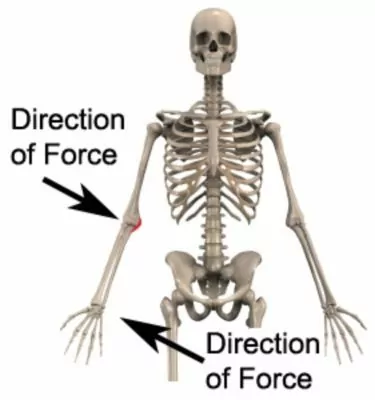
A MCL tear may range from a small partial tear resulting in minimal pain, to a complete rupture of the MCL resulting in significant pain and disability. A MCL tear can be graded as follows:
- Grade 1 tear: a small number of fibres are torn resulting in some pain but allowing full function
- Grade 2 tear: a significant number of fibres are torn with moderate loss of function.
- Grade 3 tear: all fibres are ruptured resulting in elbow instability and major loss of function. Other structures may also be injured such as the cartilage and joint capsule of the elbow.
Causes of a MCL tear
MCL tears typically occur during activities placing excessive strain on the MCL. This may occur suddenly, due to a specific incident involving a sideways or valgus force to the elbow, or, more commonly, due to repetitive strain associated with overuse (such as repetitive throwing).
In the throwing athlete, the “winding up” or “cocked” phase of the throwing motion (just prior to throwing) places significant stretching force on the MCL. As a result, MCL tears frequently occur due to overuse associated with repetitive throwing (especially in throwers who ‘open up too soon’ or throw with a low arm) and are particularly common in baseball pitchers, cricketers and javelin throwers.
Occasionally an MCL tear is seen in contact sports and may occur due to a collision to the outer elbow (i.e. a valgus force – figure 2), forcing the elbow to bend in the wrong direction (such as another player falling across the outside of the elbow).
Signs and Symptoms of a MCL tear
Patients with a MCL tear typically experience pain at the inner aspect of the elbow. It is also usually sore to firmly touch the affected area. Those MCL tears that occur due to a specific incident may notice an audible snap or tearing sound at the time of injury. In those patients whose injury occurs from overuse, symptoms usually develop gradually and progressively over a period of time.
In minor cases of a MCL tear (whether traumatic or due to overuse), patients may be able to continue activity only to experience an increase in pain, swelling and stiffness in the elbow after activity with rest (particularly first thing in the morning). As the condition progresses (particularly in the throwing athlete), pain may increase during activity and can eventually prevent activity performance.
In cases of a complete rupture of the MCL, pain is usually severe at the time of injury, however, may sometimes quickly subside. Patients may also experience a feeling of the elbow going out and then going back in as well as a rapid onset of swelling (within the first few hours following injury). Patients with a complete MCL tear generally can not continue activity due to pain or the elbow feeling “unstable”. They may also experience a feeling of elbow weakness, with bruising and elbow stiffness developing over the coming days.
Diagnosis of a MCL tear
A thorough subjective and objective examination from a physiotherapist is usually sufficient to diagnose a MCL tear. Investigations such as an X-ray, ultrasound, MRI scan or CT scan may be required to confirm diagnosis and to determine the extent of damage or involvement of other structures within the elbow.
Treatment for a MCL tear
Most patients with this condition heal well with appropriate physiotherapy treatment. The success rate of treatment is largely dictated by patient compliance. A vital aspect of treatment is that the patient rests sufficiently from any activity that increases their pain (a brace or protective taping may be required).
Activities placing large amounts of stress on the MCL should also be minimized, particularly throwing activities. Resting from aggravating activities ensures the body can begin the healing process in the absence of further tissue damage. Once the patient can perform these activities pain free a gradual return to these activities is indicated provided there is no increase in symptoms.
Ignoring symptoms or adopting a ‘no pain, no gain’ attitude is likely to lead to the condition becoming chronic. Immediate, appropriate treatment in patients with a MCL tear is essential to ensure a speedy recovery. Once the condition is chronic, healing slows significantly resulting in markedly increased recovery times, an increased likelihood of future recurrence.
Patients with a MCL tear should follow the R.I.C.E. Regime in the initial phase of injury. The R.I.C.E regime is beneficial in the first 72 hours following injury or when inflammatory signs are present (i.e. morning pain or pain with rest). The R.I.C.E. regime involves resting from aggravating activities (this may include the use of a brace or protective tape), regular icing, the use of a compression bandage and keeping the arm elevated. Anti-inflammatory medication may also significantly hasten the healing process by reducing the pain and swelling associated with inflammation.
Patients with this condition should perform pain-free flexibility and strengthening exercises as part of their rehabilitation to ensure an optimal outcome. The treating physiotherapist can advise which exercises are most appropriate for the patient and when they should be commenced.
A graduated return to activity or sport as guided by the treating physiotherapist is required in the final stages of treatment for this condition. Correction of throwing technique is particularly important in those cases where faulty biomechanics have contributed. Upon return to sport, the use of taping or a protective brace may also be required to reduce the likelihood of recurrence.
Prognosis of a MCL tear
With appropriate management, most patients with a minor to moderate MCL tear (grades 1 and 2) can return to sport or normal activity within 2 – 8 weeks. Patients with a complete rupture of the MCL (grade 3) and associated instability may require surgical intervention to repair the torn ligament and ensure an optimal outcome. These patients are likely to require a significantly longer rehabilitation period to gain optimum function. Patients with a MCL tear who have additional damage to other structures of the elbow are also likely to have an extended rehabilitation period.
Physiotherapy for a MCL tear
Physiotherapy for patients with a MCL tear is vital to hasten the healing process, ensure an optimal outcome and reduce the likelihood of future recurrence. Treatment may comprise:
- soft tissue massage
- joint mobilization
- taping
- bracing
- ice or heat treatment
- electrotherapy (e.g. ultrasound)
- anti-inflammatory advice
- exercises to improve flexibility and strength
- education
- activity modification advice
- sporting technique correction (e.g. throwing)
- a gradual return to activity program
Other intervention for a MCL tear
Despite appropriate physiotherapy management, a small percentage of patients with this condition do not improve adequately. When this occurs the treating physiotherapist or doctor can advise on the best course of management. This may involve further investigation such as an X-ray, CT scan or MRI, pharmaceutical intervention, corticosteroid injection, or a review by a specialist who can advise on any procedures that may be appropriate to improve the condition. Surgical reconstruction of the MCL may be required in cases of a complete MCL rupture when associated elbow instability is present.
Exercises for a MCL tear
The following exercises are commonly prescribed to patients with a MCL tear. You should discuss the suitability of these exercises with your physiotherapist prior to beginning them. Generally, they should be performed 3 times daily and only provided they do not cause or increase symptoms.
Elbow Bend to Straighten
Bend and straighten your elbow as far as possible pain-free (figure 3). Repeat 10 times provided there is no increase in symptoms.
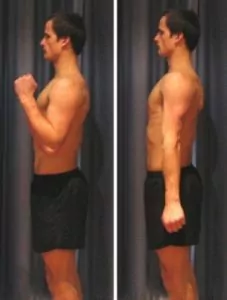
Forearm Rotation
Begin with your elbow at your side and bent to 90 degrees (figure 4). Turn your palm up and down as far as possible pain-free. Repeat 10 times provided there is no increase in symptoms.
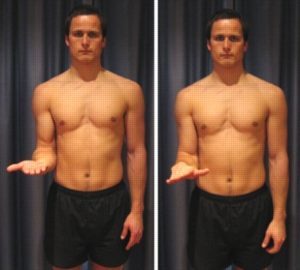
Tennis Ball Squeeze
Begin this exercise holding a tennis ball (figure 5). Squeeze the tennis ball as hard as possible and comfortable without pain. Hold for 5 seconds and repeat 10 times provided there is no increase in symptoms.
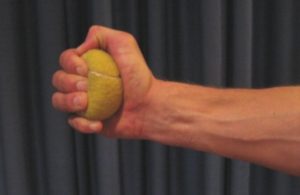
Theraband Pronation
Begin this strengthening exercise with a resistance band around your hand as demonstrated (figure 6). Your elbow should be at your side and bent to 90 degrees. Slowly rotate your forearm against the resistance band so your palm faces down. Perform 10 – 30 repetitions provided there is no increase in symptoms. If the exercise is too easy, increase the resistance of the resistance band.

Theraband Bicep Curl
Begin this strengthening exercise with a resistance band under your feet and around your hands as demonstrated (figure 7). Your back and elbows should be straight. Slowly bend your elbows against the resistance band tightening your biceps. Perform 10 – 30 repetitions provided there is no increase in symptoms.
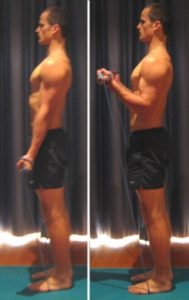
Other Exercises
View more elbow strengthening exercises.
View more elbow flexibility exercises.
Physiotherapy products for a MCL tear
Some of the most commonly recommended products by physiotherapists to hasten healing and speed recovery in patients with this condition include:
To purchase physiotherapy products for an MCL tear visit the PhysioAdvisor Shop.
Find a Physio for a MCL tear
Find a physiotherapist in your local area to treat a MCL tear.

Link to this Page
If you would like to link to this article on your website, simply copy the code below and add it to your page:
<a href="https://physioadvisor.com.au/injuries/elbow-forearm/mcl-tear”>MCL Tear – PhysioAdvisor.com</a><br/>PhysioAdvisor offers expert physiotherapy information on a MCL tear of the elbow including: signs and symptoms, causes, diagnosis, treatment, exercises, physiotherapy products and more...
Return to the top of MCL Tear.

